General Sir John Monash, Personal Files Book 18, 21 April - 8 May 1918, Part 3
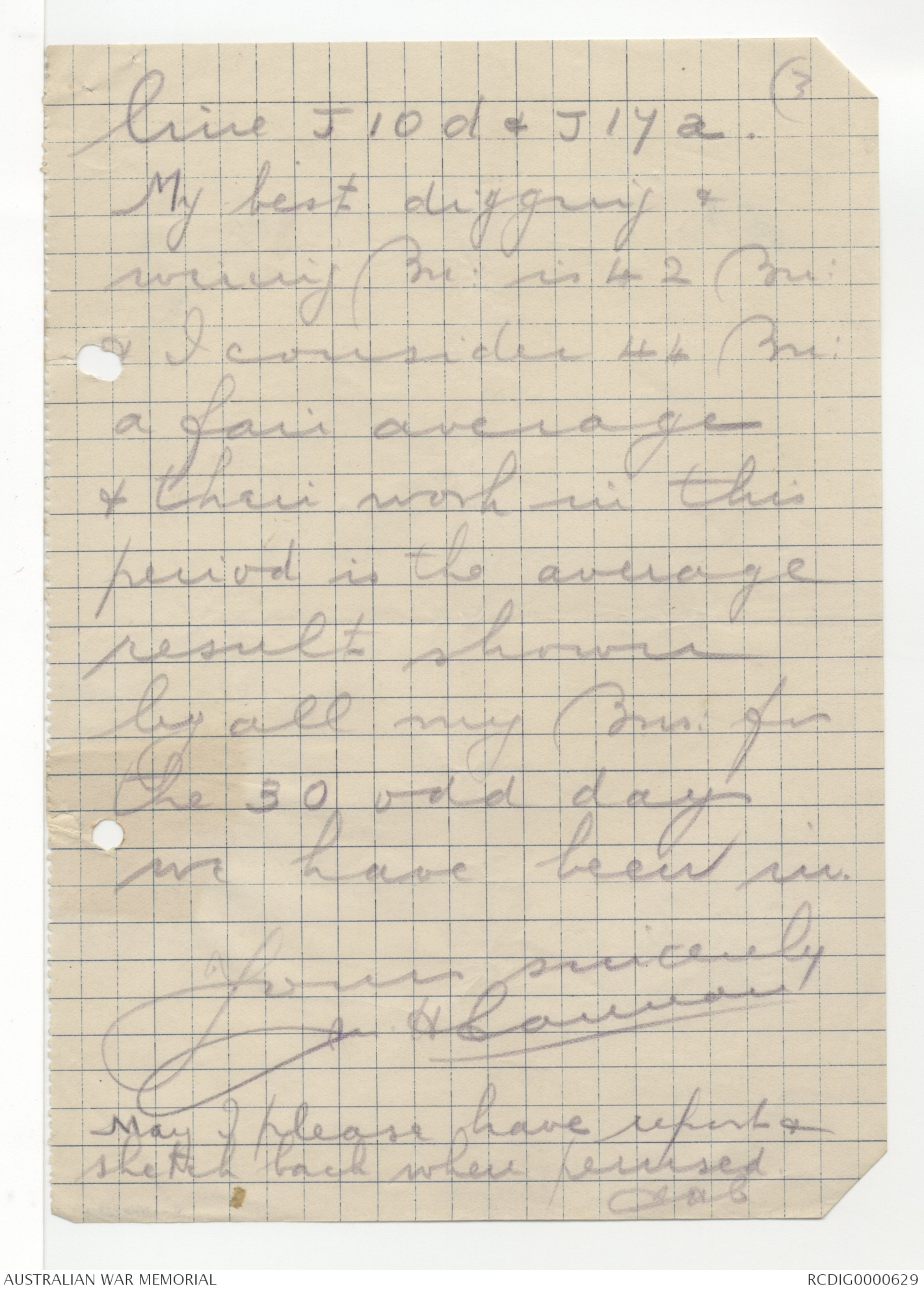
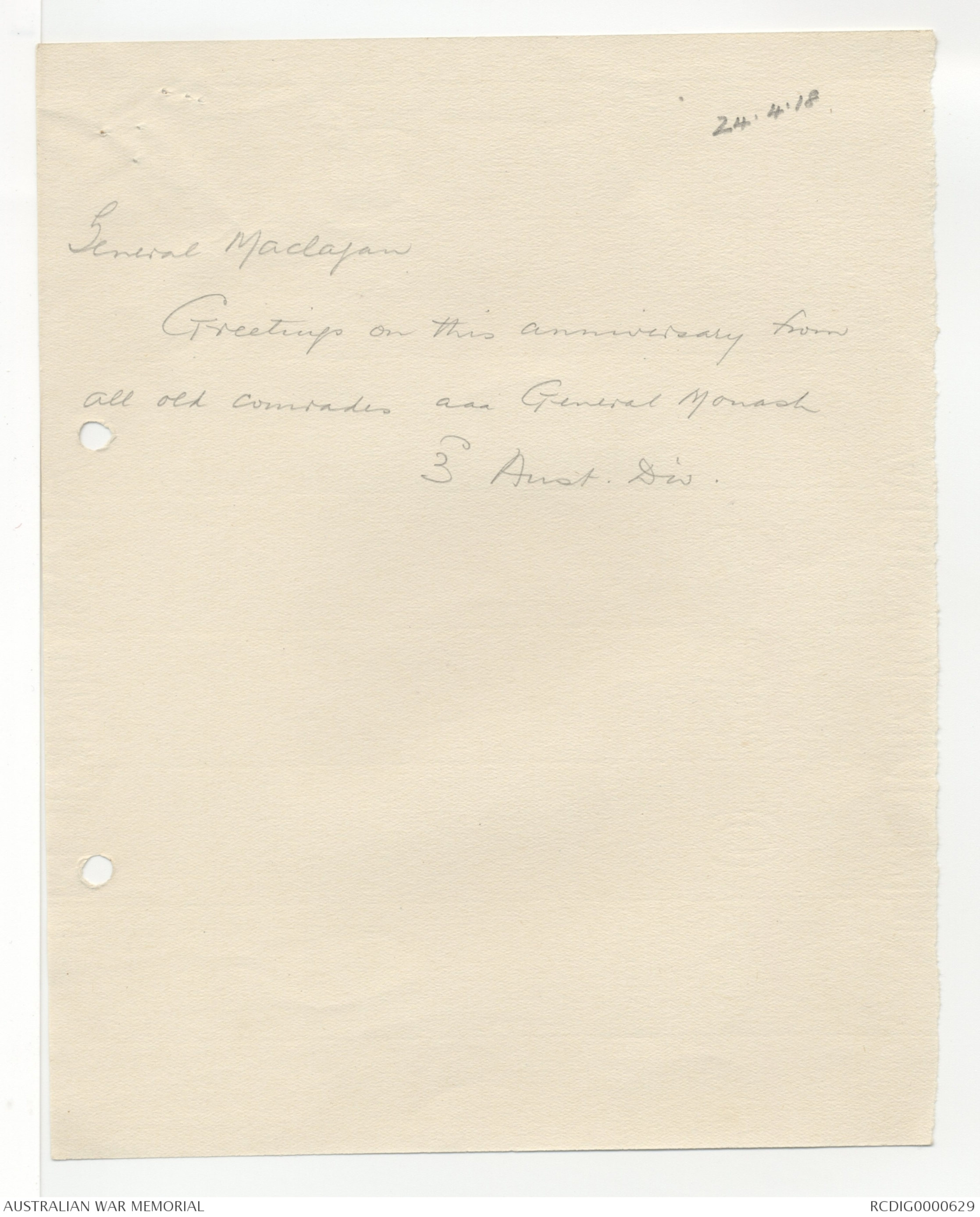
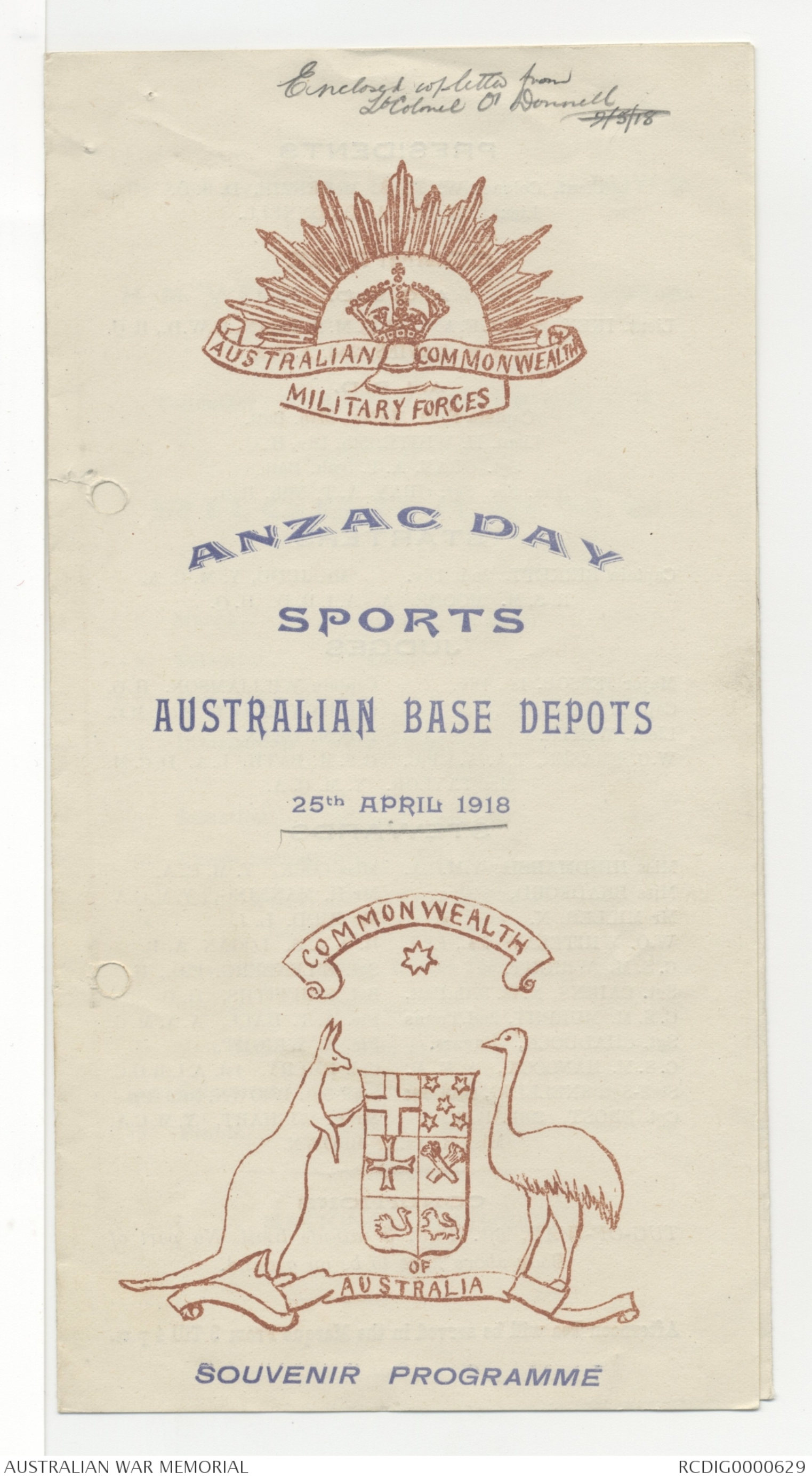
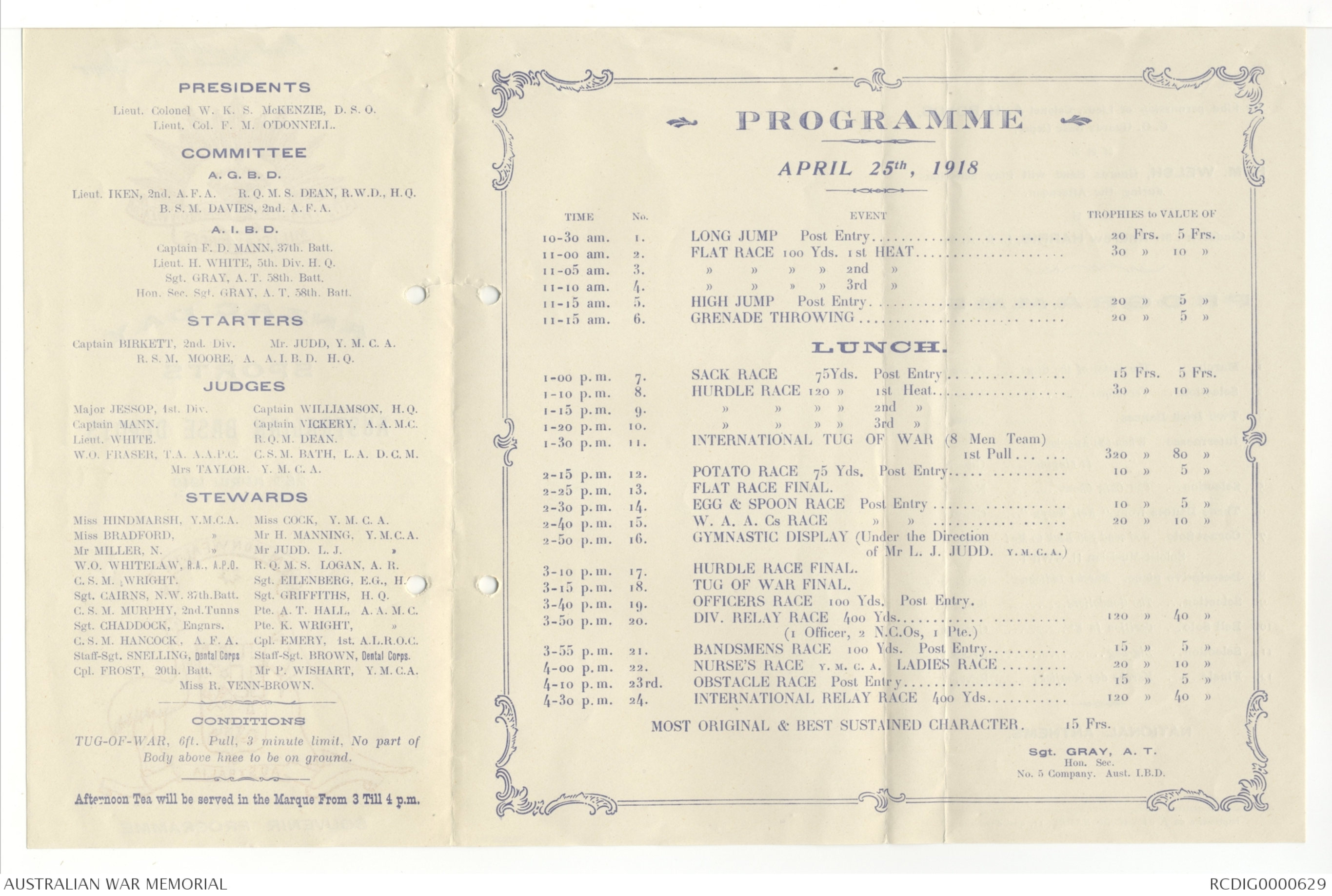
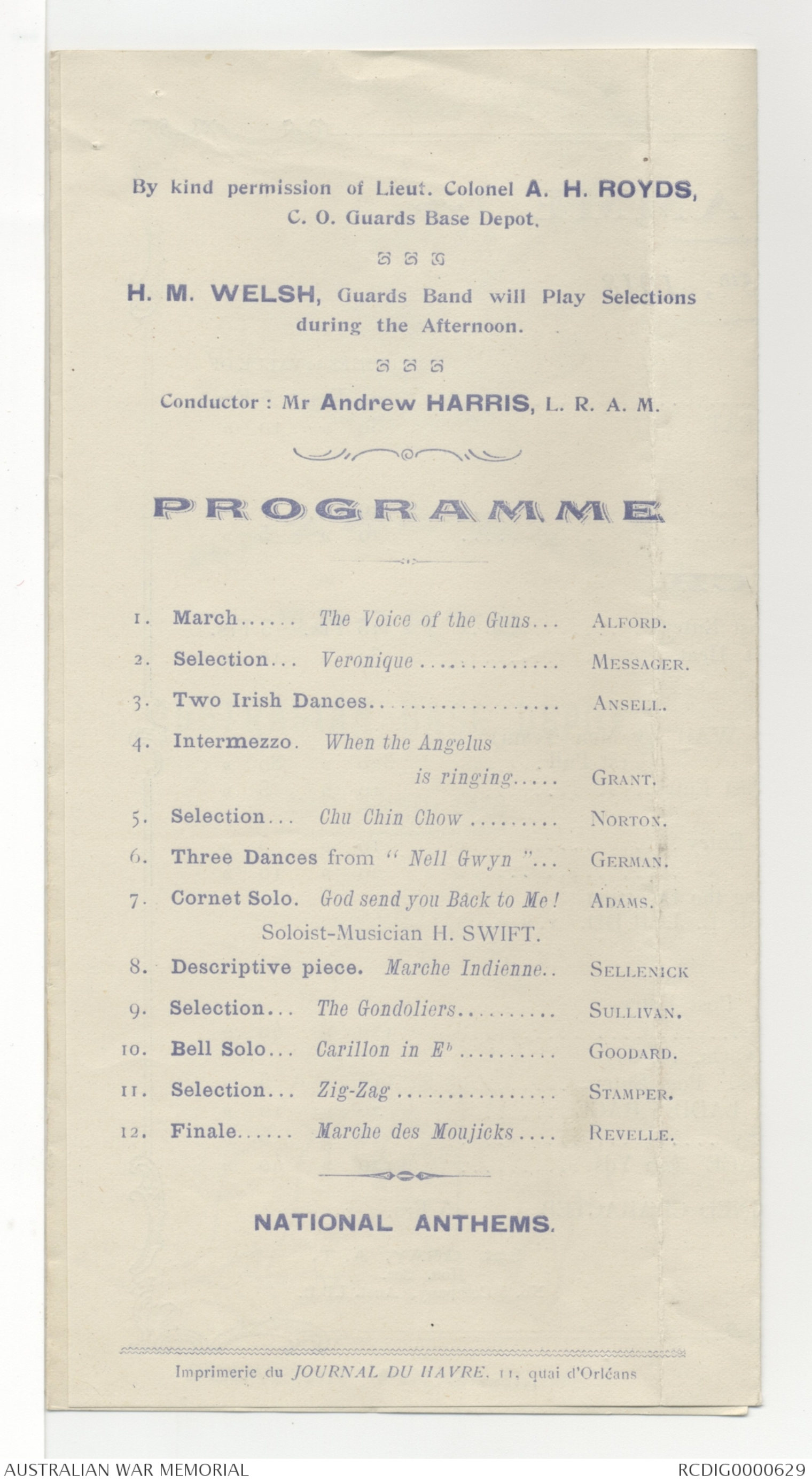
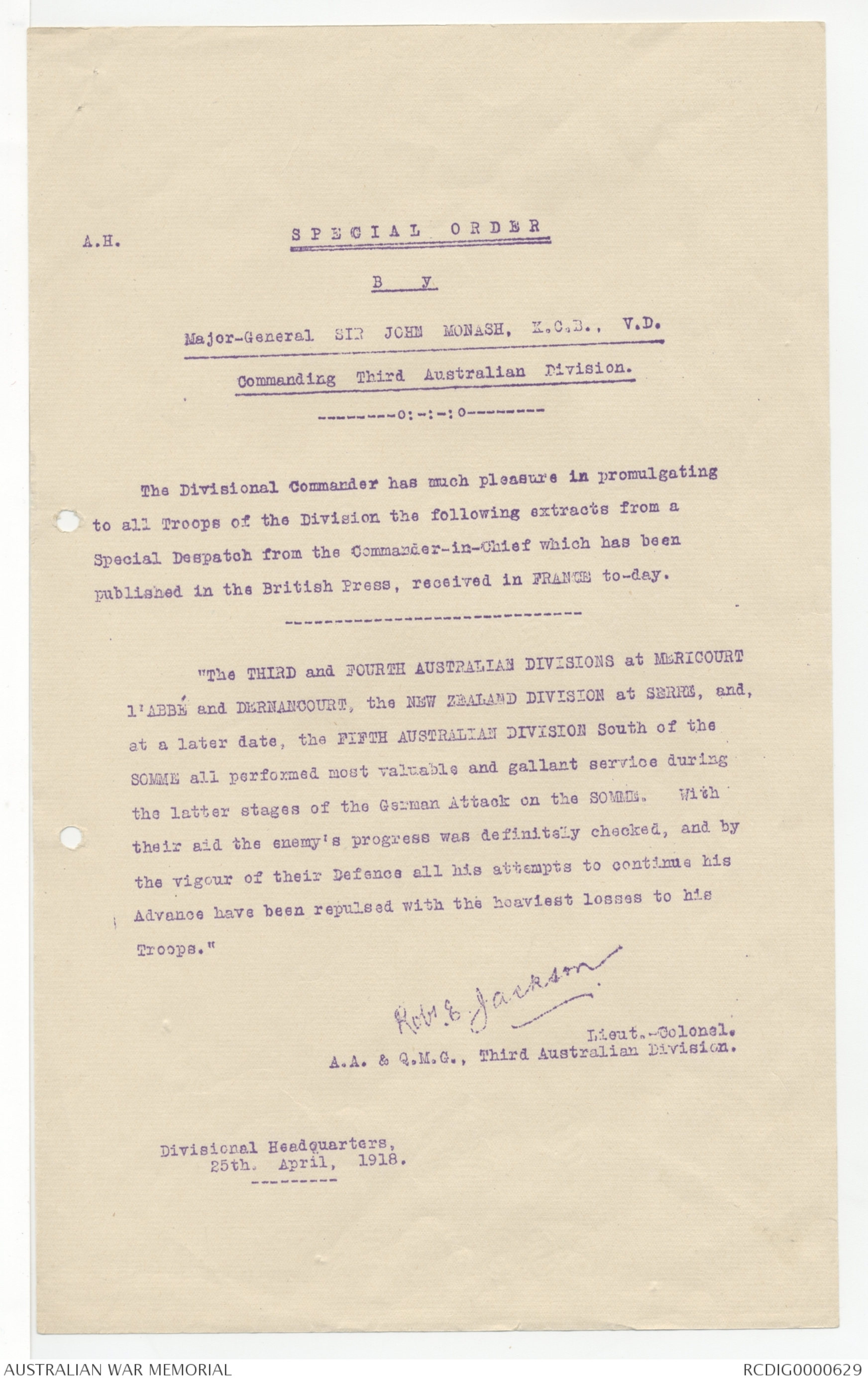
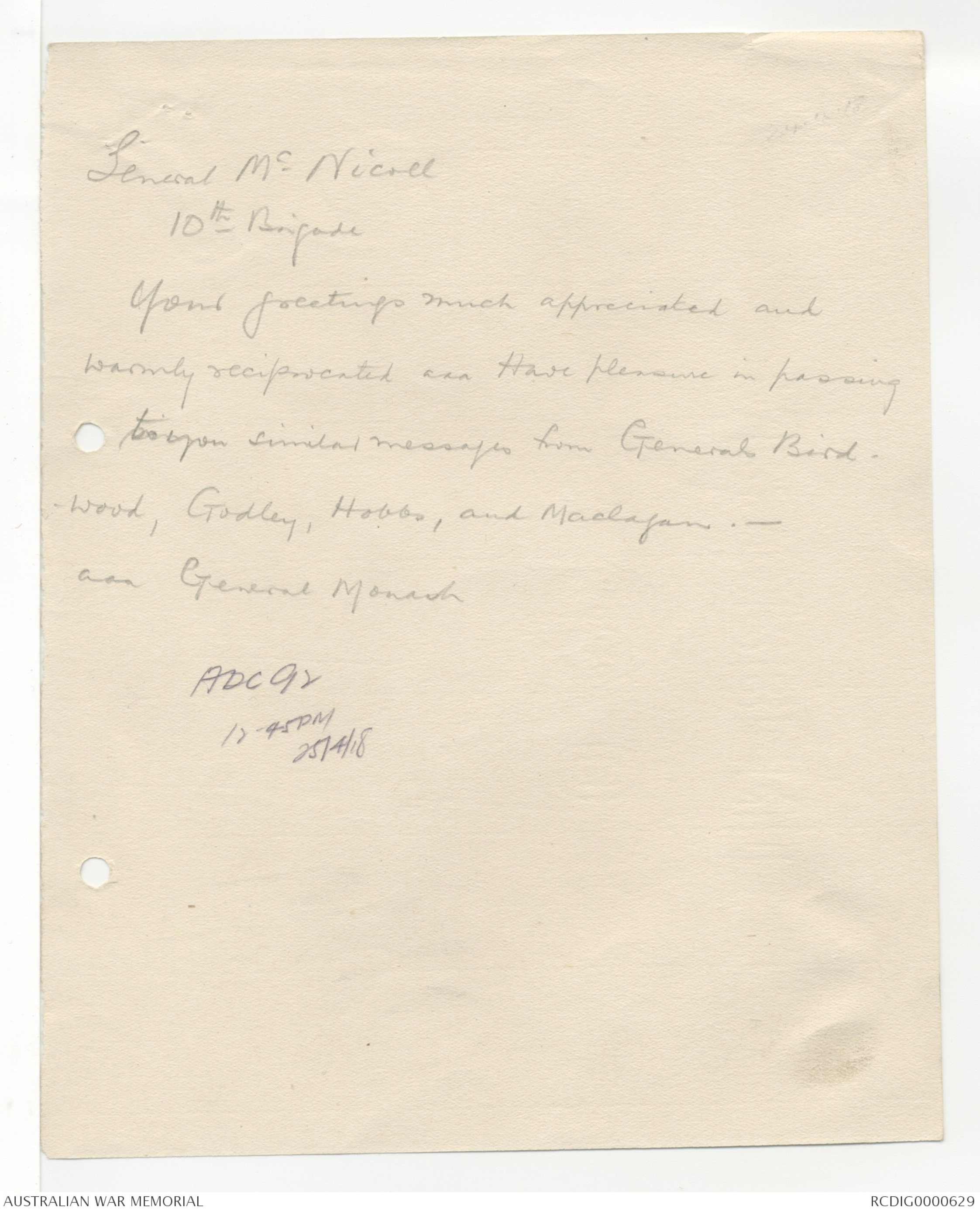
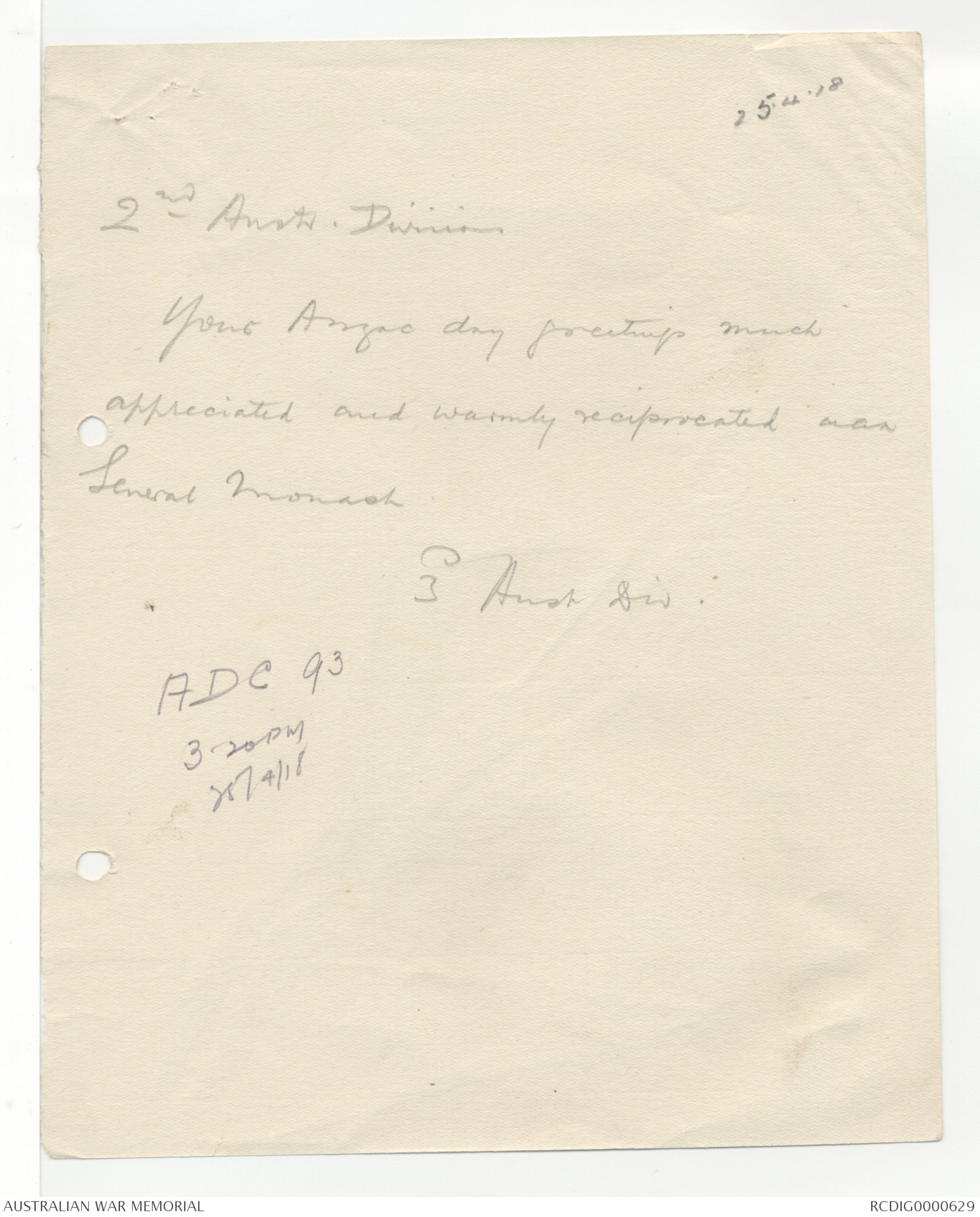
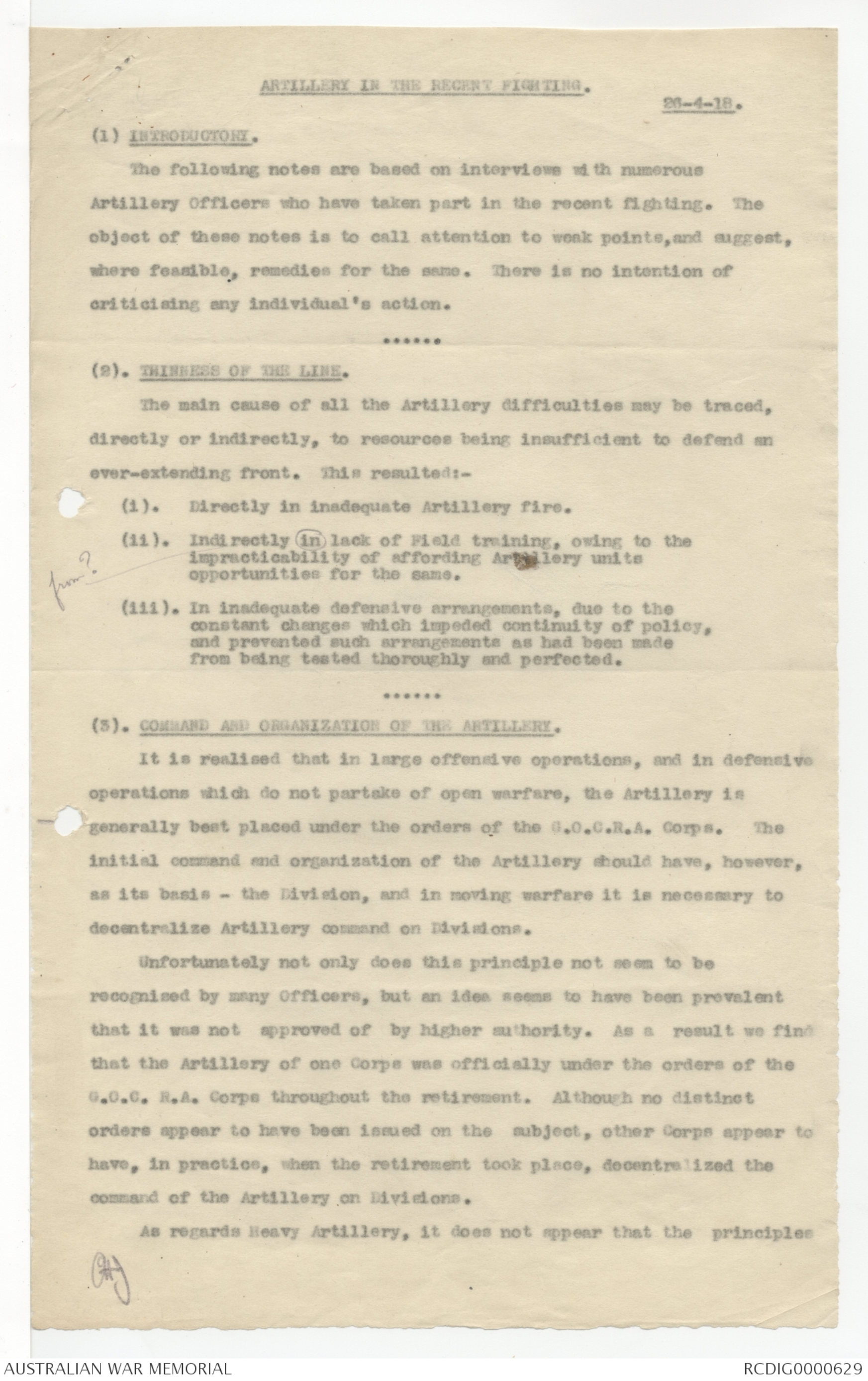
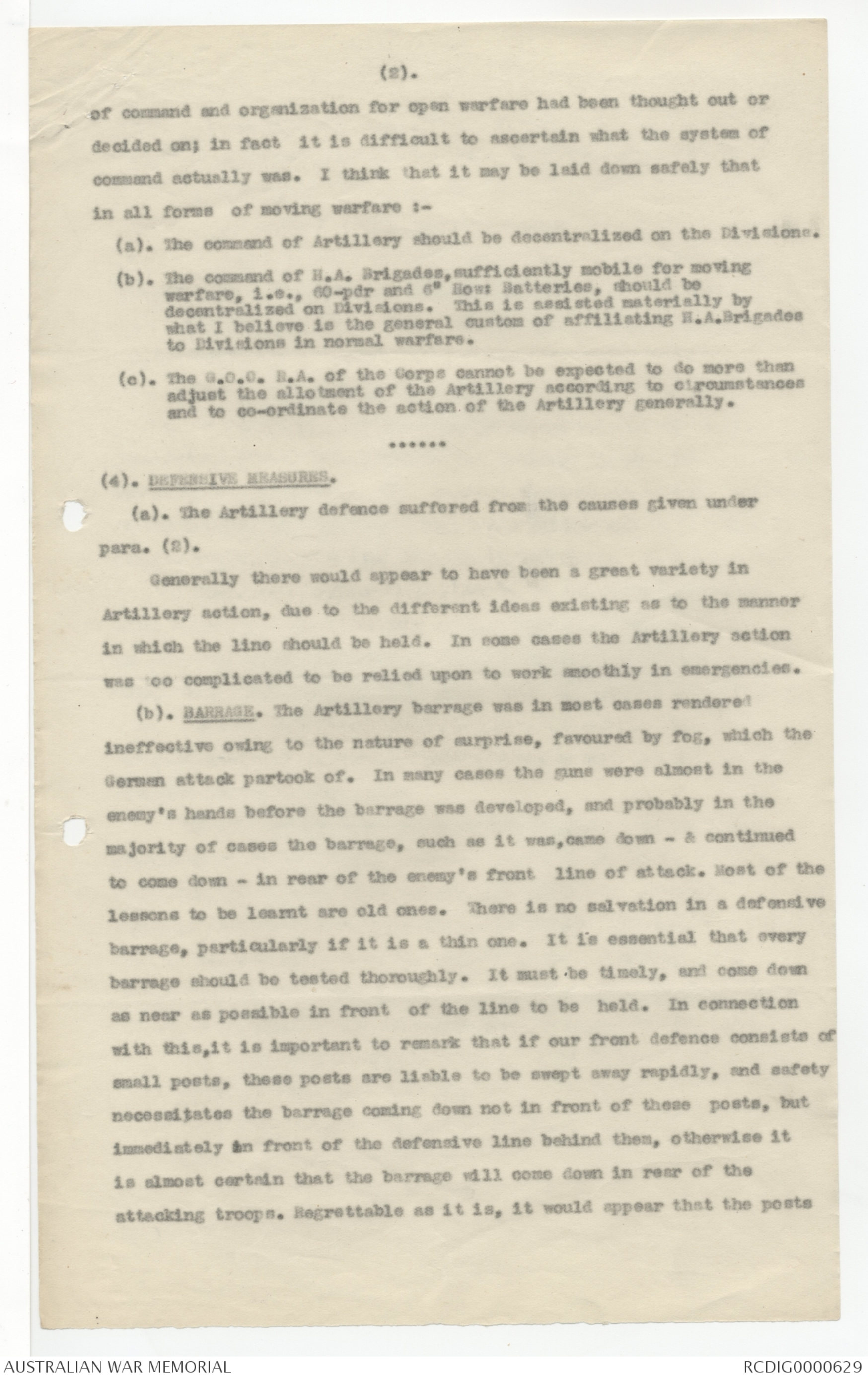
(3
line J 10 d & J 17 a.
My best digging &
wiring Bn is 42 Bn
& I consider 44 Bn
a fair average
& their work in this
period is the average
result shown
by all my Bns for
the 30 odd days
we have been in.
Yours sincerely
J H Cannon
May I please have report &
sketch back when perused
JHC
24.4.18
General Maclagan
Greetings on this anniversary from
all old comrades aaa General Monash
3d Aust. Div.
Enclosed w/ letter from
Lt Colonel O'Donnell9/5/18
AUSTRALIAN COMMONWEALTH
MILITARY FORCES
ANZAC DAY
SPORTS
AUSTRALIAN BASE DEPOTS
25th APRIL 1918
COMMONWEALTH
OF
AUSTRALIA
SOUVENIR PROGRAMME
PRESIDENTS
Lieut. Colonel W.K.S. McKENZIE, D.S.O.
Lieut. Col. F.M. O’DONNELL.
COMMITTEE
A.G.B.D.
Lieut. IKEN, 2nd, A.F.A. R.Q.M.S. DEAN, R.W.D., H.Q.
B.S.M. DAVIES, 2nd, A.F.A.
A.I.B.D.
Captain F.D. MANN, 37th. Batt.
Lieut. H. WHITE, 5th. Div. H.Q.
Sgt. GRAY, A.T. 58th. Batt.
Hon. Sec. Sgt. GRAY, A.T. 58th. Batt.
STARTERS
Captain BIRKETT, 2nd, Div. Mr JUDD, Y.M.C.A.
R.S.M. MOORE, A. A.I.B.D. H.Q.
JUDGES
Major JESSOP, 1st. Div. Captain WILLIAMSON, H.Q.
Captain MANN. Captain VICKERY, A.A.M.C.
Lieut. WHITE. R.Q.M. DEAN.
W.O. FRASER, T.A. A.A.P.C. C.S.M. BATH, L.A. D.C.M.
Mrs TAYLOR, Y.M.C.A.
STEWARDS
Miss HINDMARSH, Y.M.C.A. Miss COCK, Y.M.C.A.
Miss BRADFORD, " Mr H. MANNING, Y.M.C.A.
Mr. MILLER, N. " Mr JUDD. L.J. "
W.O. WHITELAW, R.A., A.P.O. R. Q. M.S. LOGAN, A. R.
C. S. M. WRIGHT. Sgt. EILENBERG. E.G.,H.Q.
Sgt. CAIRNS, N.W. 37th. Batt. Sgt. GRIFFITHS, H.Q.
C. S. M. MURPHY, 2nd. Tunns. Pte. A. T. HALL., A.A. M. C.
Sgt. CHADDOCK, Engnrs. Pte. K. WRIGHT , "
C. S. M. HANCOCK, A. F. A. Cpl. EMERY, 1st. A.L.R.O.C.
Staff-Sgt. SNELLING, Dental Corps. Staff-Sgt BROWN, Dental Corps.
Cpl. FROST, 20th. Batt. Mr P. WISHART, Y.M.C.A.
Miss R. VENN-BROWN
CONDITIONS
TUG -OF-WAR, 6ft. Pull,3 minute limit. No part of
Body above knee to be on ground.
Afternoon Tea will be served in the Marque From 3 Till 4 p.m.
PROGRAMME
APRIL 25th, 1918
TIME No. EVENT TROPHIES to VALUE OF
10-30 am. 1. LONG JUMP Post Entry. . . . . . . . . . . . . . . . . . . . . 20 Frs. 5Frs.
11-00 am. 2. FLAT RACE 100 Yds. 1st HEAT . . . . . . . . . . . . . . . . 30 " 10 "
11-05 am. 3. " " " " 2nd "
11-10 am. 4. " " " " 3rd "
11-15 am. 5. HIGH JUMP Post Entry . . . . . . . . . . . . . . . . . . . . 20 " 5 "
11-15 am. 6. GRENADE THROWING . . . . . . . . . . . . . . . . . . . . . 20 " 5 "
LUNCH
1-00 p.m. 7. SACK RACE 75 Yds. Post Entry . . . . . . . . . . . . . . . 15 Frs. 5Frs.
1-10 p.m. 8. HURDLE RACE 120 " 1st Heat . . . . . . . . . . . . . 30 " 10 "
1-15 p.m. 9. " " " 2nd "
1-20 p.m. 10. “ " " 3rd "
1-30 p.m. 11. INTERNATIONAL TUG OF WAR (8 Men Team)
1st Pull . . . . 320 " 80 "
2-15 p.m. 12. POTATO RACE 75 Yds. Post Entry . . . . . . . . . . . 10 " 5 "
2-25 p.m. 13. FLAT RACE FINAL.
2-30 p.m. 14. EGG & SPOON RACE Post Entry . . . . . . . . . . . . . 10 " 5 "
2-40 p.m. 15. W. A. A. Cs RACE " " . . . . . . . . . . . . . 20 " 10 "
2-50 p.m. 16. GYMNASTIC DISPLAY (Under the Direction
of Mr L. J. JUDD. Y.M.C.A.)
3-10 p.m. 17. HURDLE RACE FINAL.
3-15 p.m. 18. TUG OF WAR FINAL.
3-40 p.m. 19. OFFICERS RACE 100 Yds Post Entry.
3-50 p.m. 20. DIV. RELAY RACE 400 Yds . . . . . . . . . . . . . . . . . . . . . 120 " 40 "
(1 Officer, 2 N.C.Os, 1 Pte.)
3-55 p.m. 21. BANDSMEN RACE 100 Yds. Post Entry . . . . . . . 15 " 5 "
4-00 p.m. 22. NURSE'S RACE Y.M.C.A.LADIES RACE . . . . . . . . . . 20 " 10 "
4-10 p.m. 23rd OBSTACLE RACE Post Entry . . . . . . . . . . . . . . . . . . . 15 " 5 "
4-30 p.m. 24 INTERNATIONAL RELAY RACE 400 Yds . . . . . . . . 120 " 40 "
MOST ORIGINAL & BEST SUSTAINED CHARACTER. 15 Frs.
Sgt. GRAY, A. T.
Hon. Sec.
No. 5 Company, Aust. I.B.D.
By kind permission of Lieut. Colonel A. H. ROYDS,
C.O. Guards Base Depot.
H. M. WELSH, Guards Band will Play Selections
during the Afternoon.
Conductor : Mr Andrew HARRIS, L. R. A. M.
PROGRAMME
- March . . . . . The Voice of the Guns . . . ALFORD.
- Selection . . . Veronique . . . . . . . . . . . . . . MESSAGER.
3. Two Irish Dances . . . . . . . . . . . . . . . . . . . . ANSELL.
4. Intermezzo. When the Angelus
is ringing. . . . . . . . . . . . . . GRANT.
5. Selection . . . Chu Chin Chow . . . . . . . . NORTON.
6. Three Dances from " Nell Gwyn " . . . . GERMAN.
7. Cornet Solo. God send you Back to Me! ADAMS.
Soloist-Musician H. SWIFT.
8. Descriptive piece. Marche Indienne . . SELLENICK.
9. Selection. . . The Gondoliers . . . . . . . . . . SULLIVAN.
10. Bell Solo . . Carillon in Eb . . . . . . . . . . . . GOODARD.
11. Selection . . . Zig-Zag . . . . . . . . . . . . . . . . . . STAMPER.
12. Finale . . . . . . Marche des Moujicks . . . . . REVELLE.
NATIONAL ANTHEMS.
A.H. SPECIAL ORDER
B y
Major-General SIR JOHN MONASH, K.C.B., V.D.
Commanding Third Australian Division.
The Divisional Commander has much pleasure in promulgating
to all Troops of the Division the following extracts from a
Special Despatch from the Commander-in-Chief which has been
published in the British Press, received in FRANCE to-day.
"The THIRD and FOURTH AUSTRALIAN DIVISIONS at MERICOURT
l'ABBÉ and DERNANCOURT, the NEW ZEALAND DIVISION at SERRE, and,
a later date, the FIFTH AUSTRALIAN DIVISION south of the
SOMME all performed most valuable and gallant service during
the latter stages of the German Attack on the SOMME. With
their aid the enemy's progress was definitely checked, and by
the vigour of their Defence all his attempts to continue his
Advance have been repulsed with the heaviest losses to his
Troops."
Rob. E Jackson
Lieut.-Colonel.
A.A. & Q.M.G., Third Australian Division.
Divisional Headquarters,
25th. April, 1918.
General McNicoll
10th Brigade
Your greetings much appreciated and
warmly reciprocated aaa Have pleasure in passing
to you similar messages from Generals Birdwood,
Godley, Hobbs, and Maclagan. -
aaa General Monash
ADC 92
12-45PM
25/4/18
25.4.18
2nd Austn. Division
Your Anzac day greetings much
appreciated and warmly reciprocated aaa
General Monash
3 d Aust Div.
ADC 93
3.20 PM
25/4/18
ARTILLERY IN THE RECENT FIGHTING.
26-4-18
(1) INTRODUCTORY.
The following notes are based on interviews with numerous
Artillery Officers who have taken part in the recent fighting. The
object of these notes is to call attention to weak points, and suggest,
where feasible, remedies for the same. There is no intention of
criticising any individual's action.
(2). THINNESS OF THE LINE.
The main cause of all the Artillery difficulties may be traced,
directly or indirectly, to resources being insufficient to defend an
ever-extending front. This resulted :-
(i). Directly in inadequate Artillery fire.
(ii). Indirectly (in) [*from*] lack of Field training, owing to the
impracticality of affording Artillery units
opportunities for the same.
(iii). In inadequate defensive arrangements, due to the
constant changes which impeded continuity of policy,
and prevented such arrangements as had been made
from being tested thoroughly and perfected.
(3). COMMAND AND ORGANIZATION OF THE ARTILLERY.
It is realised that in large offensive operations, and in defensive
operations which do not partake of open warfare, the Artillery is
generally best placed under the orders of the G.O.C.R.A. Corps. The
initial command and organization of the Artillery should have, however,
as its basis - the Division, and in moving warfare it is necessary to
decentralize Artillery command on Divisions.
Unfortunately not only does this principle not seem to be
recognised by many Officers, but an idea seems to have been prevalent
that it was not approved of by higher authority. As a result we find
that the Artillery of one Corps was officially under the orders of the
G.O.C. R.A. Corps throughout the retirement. Although no distinct
orders appear to have been issued on the subject, other Corps appear to
have, in practice, when the retirement took place, decentralized the
command of the Artillery on Divisions.
As regards Heavy Artillery, it does not appear that the principles
CHJ
(2).
of command and organization for open warfare had been thought out or
decided on; the fact it is difficult to ascertain what the system of
command actually was. I think that it may be laid down safely that
in all forms of moving warfare :-
(a). The command of Artillery should be decentralized on the Divisions.
(b). The command of H. A. Brigades,sufficiently mobile for moving
warfare, i.e., 60-pdr and 6" How: Batteries, should be
decentralized on Divisions. This is assisted materially by
what I believe is the general custom of affiliating H.A.Brigades
to Divisions in normal warfare.
(c). The G.O.C. B.A. of the Corps cannot be expected to do more than
adjust the allotment of the Artillery according to circumstances
and to co-ordinate the action of the Artillery generally.
(4). DEFENSIVE MEASURES.
(a). The Artillery defence suffered from the causes given under
para. (2).
Generally there would appear to have been a great variety in
Artillery action, due to the different ideas existing as to the manner
in which the line should be held. In some cases the Artillery section
was too complicated to be relied upon to work smoothly in emergencies.
(b). BARRAGE. The Artillery barrage was in most cases rendered
ineffective owing to the nature of surprise, favoured by fog, which the
German attack partook of. In many cases the guns were almost in the
enemy's hands before the barrage was developed, and probably in the
majority of cases the barrage, such as it was,came down - & continued
to come down - in rear of the enemy's front line of attack. Most of the
lessons to be learnt are old ones. There is no salvation in a defensive
barrage, particularly if it is a thin one. It is essential that every
barrage should be tested thoroughly. It must be timely, and come down
as near as possible in front of the line to be held. In connection
with this,it is important to remark that if our front defence consists of
small posts, these posts are liable to be swept away rapidly, and safety
necessitates the barrage coming down not in front of these posts, but
immediately in front of the defensive line behind them, otherwise it
is almost certain that the barrage will come down in rear of the
attacking troops. Regrettable as it is, it would appear that the posts
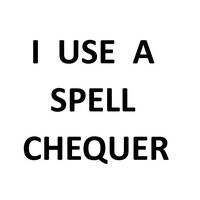 Not Yet Replaced By AI
Not Yet Replaced By AIThis transcription item is now locked to you for editing. To release the lock either Save your changes or Cancel.
This lock will be automatically released after 60 minutes of inactivity.